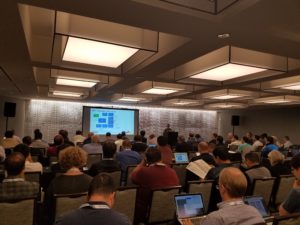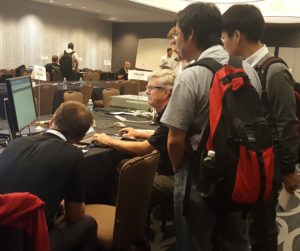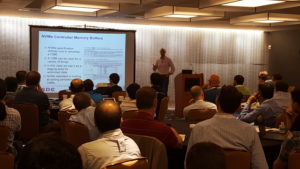The SNIA Storage Developer Conference (SDC) is coming up September 24-27, 2018 at the Hyatt  Regency Santa Clara CA. The agenda is now live!
Regency Santa Clara CA. The agenda is now live!
SNIA on Storage is teaming up with the SNIA Technical Council to dive into major themes of the  2018 conference. The SNIA Technical Council takes a leadership role to develop the content for each SDC, so SNIA on Storage spoke with Bill Martin, SNIA Technical Council Co-Chair and SSD I/O Standards at Samsung Electronics, to understand why SDC is bringing NVMe and NVMe-oF to conference attendees.
2018 conference. The SNIA Technical Council takes a leadership role to develop the content for each SDC, so SNIA on Storage spoke with Bill Martin, SNIA Technical Council Co-Chair and SSD I/O Standards at Samsung Electronics, to understand why SDC is bringing NVMe and NVMe-oF to conference attendees.
SNIA On Storage (SOS): What is NVMe and why is SNIA emphasizing it as one of their key areas of focus for SDC?
Bill Martin (BM): NVMeTM, also known as NVM ExpressR, is an open collection of standards and information to fully expose the benefits of non-volatile memory (NVM) in all types of computing environments from mobile to data center.
SNIA is very supportive of NVMe. In fact, earlier this year, SNIA, the Distributed Management Task Force (DMTF), and the NVM Express organizations formed a new alliance to coordinate standards for managing solid state drive (SSD) storage devices. This alliance brings together multiple standards for managing the issue of scale-out management of SSDs. It’s designed to enable an all-inclusive management experience by improving the interoperable management of information technologies.
With interest both from within and outside of SNIA from architects, developers, and implementers on how these standards work, the SNIA Technical Council decided to bring even more sessions on this important area to the SDC audience this year. We are proud to include 16 sessions on NVMe topics over the four days of the conference.
SOS: What will I learn about NVMe at SDC? Read More
 focused on
focused on  c Storage, and SMB3 plugfests; ten Birds-of-a-Feather Sessions, and amazing networking among 450+ attendees. Sessions on NVMe over Fabrics won the title of most attended, but Persistent Memory, Object Storage, and Performance were right behind. Many thanks to SDC 2016 Sponsors, who engaged attendees in exciting technology discussions.
c Storage, and SMB3 plugfests; ten Birds-of-a-Feather Sessions, and amazing networking among 450+ attendees. Sessions on NVMe over Fabrics won the title of most attended, but Persistent Memory, Object Storage, and Performance were right behind. Many thanks to SDC 2016 Sponsors, who engaged attendees in exciting technology discussions. You’ll want to stream keynotes from Citigroup, Toshiba, DSSD, Los Alamos National Labs, Broadcom, Microsemi, and Intel – they’re available now on demand on SNIA’s YouTube channel,
You’ll want to stream keynotes from Citigroup, Toshiba, DSSD, Los Alamos National Labs, Broadcom, Microsemi, and Intel – they’re available now on demand on SNIA’s YouTube channel,